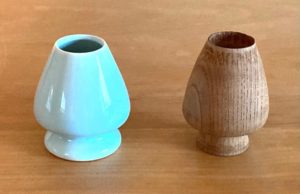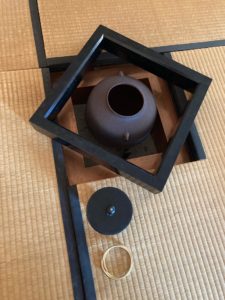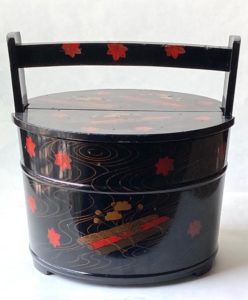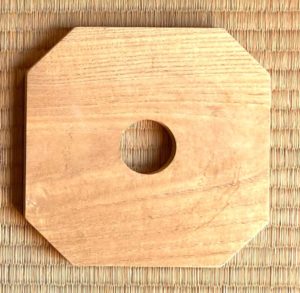Mizuya Dōgu Part 2
The sa-dō guchi, 茶道口, tea-way opening, is also called the cha-dō guchi, which is now the preferred reading.
The cha-dō guchi is a doorway leading directly onto the fumi-komi tatami, 踏込畳, step-in tatami, where o-cha, お茶, hon.-tea is presented in the cha-shitsu, 茶室, tea-room. This doorway may lead directly into the mizuya, or an adjoining hallway that leads to the mizuya. The sliding door fusuma, 襖, [sliding door panel] may be covered with opaque paper, or translucent paper as appropriate for a small Tearoom. This door panel is like a shōji but is papered on both sides, and is called tai-ko-bari fusuma, 太鼓張り襖, big-drum-stretch door panel. The paper’s translucence lets light from a candlestick, placed by the guest in the Tearoom, be seen from outside of the room.
A small Tearoom may have a separate door, other than the sadō-guchi, which is called a ka-tte guchi, 勝手口, prevail-hand opening. This doorway, which has a sliding fusuma, is used for activities that occur in the guest area of the Tearoom, such as serving food, drinks, cushions, etc. Only Tea and charcoal activities use the chadō guchi. As usual, there are exceptions. In a Tearoom that has a dai-me tatami, 台目畳, support-eye mat, with a de-ro, 出炉, the Tea presentation could use the katte guchi when the doorway is close to a ro, so that the teishu could join the guests in the Tearoom rather than sit on the daime tatami to prepare Tea.
According to tradition, every space, such as a room, has aspects of formality, including the more important direction or theoretical status. Primary to this is the concept of upper and lower, called ge-za,下座, down-seat, and kami-za, 上座, upper-seat. In general, the location of the toko-no-ma, 床の間, floor-’s-room, is identified as kamiza, and this is true in a standard yo-jō-han, 四畳半, four-mat-half, Tearoom. The tokonoma is located in the northeast corner of the room, and is identified as kamiza. Opposite the tokonoma in the southwest corner of the room is the chadō guchi, which is used by the teishu to enter and leave the Tearoom.

The cha-sen kuse-naoshi, 癖直し, habit-correct, is a utensil that is used to correct the form of the chasen after use; H. 2.4 sun kane-jaku. It is made of wood, ceramic, or porcelain, and kept in the mizuya. A ceramic utensil is preferred, as the wood retains moisture, and could alter the whisk.





The exceptional ita kama-shiki measurements, 10 to .88, can be written with the Kanji for rice, kome, 米, and metaphorically places the utensil in the center of world. This relationship is emphasized in that the ita kama-shiki is eight-sided. In the realms of Buddhism and Shintō, the number eighty-eight is symbolic of the ‘center of the world.’
Next to the place of the teishu, 亭主, house-master, in the tearoom wall may be a small sliding door that opens to a box-like structure called a dō-ko, 洞庫, cave-storehouse. This is a temporary housing for Tea utensils that may be needed by the teishu during a presentation in the Tearoom. The dōko cabinet has no bottom floor board, is lightweight, and portable, so that it can be easily moved to place and remove utensils. The sliding door closes off the activity from being seen by the guests. In his Tea hut Kon-nichi-an, 今日庵, Today’s-hut, Sen Sōtan, had a large permanent dōko that was more like a mizuya, with shelves and a su-no-ko, 簀の子, reed-’s of, floor drain area. This place provided great convenience so that Sōtan did not have to leave the Tearoom to get and remove utensils.
